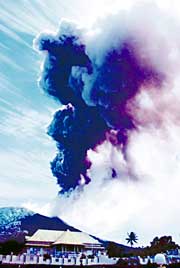The most dangerous months are November to March
Guardian and Economist, Walla News

Sopotan volcano in Indonesia, July 2003. The eruptions affect the weather, but also the other way around
English scientists claim that the chance of volcanic eruptions is greater when winter prevails in the Northern Hemisphere. The discovery may help in the future in saving some of the 500 million people living in the vicinity of volcanoes.
Every year about 60 volcanoes in the world spew lava or spread burning ash for miles. David Pyle, Ben Mason and other researchers from the University of Cambridge in England examined data relating to more than 3,200 volcanic eruptions that occurred between 1700 and 1999 - from the Andes in the south to Alaska in the north. They discovered that the chance of the occurrence of volcanic eruptions and the emission of lava in the months of November-March is 18% higher compared to the summer months.
The study, which is about to be published in the "Geophysical Research Journal of", developed from Mason's doctoral thesis, which dealt with volcanic eruption patterns. "Ben had to print the data, and after doing this for a few days he noticed that he was printing the names of the months January and February much more than June, July and August," said Dr. Pyle. "He wasn't really convinced, so he obtained records of eruptions that happened in the last 300 years. And wonder and wonder, it turned out that the outbreaks have a seasonal pattern."
Weather researchers have suspected for decades the existence of a connection between weather patterns and volcanic activity. Volcanoes emit huge amounts of carbon dioxide and water vapor into the atmosphere, increasing the greenhouse effect. But the largest eruptions also spread huge amounts of soot and ash, which can reduce the amount of sunlight reaching the surface of the Earth and lower temperatures. For example, researchers have pointed out a connection between the massive eruption of the Tambora volcano in Indonesia in 1815, in which 70,000 people were killed, and the extreme climatic phenomena of 1816, notoriously known as "the year there was no summer", in which crops were destroyed and famine prevailed in Europe and the north America.
The new research hypothesizes that just as volcanoes can affect the weather, the weather can somehow affect volcanoes. The English researchers do not provide a detailed explanation for the phenomenon, but they speculate that this is related to the fact that the rain and snow that fall in large quantities in the winter months exert pressure on the surface of the earth and change its shape in a minimal way. These changes do not cause the volcanic eruptions, but affect the timing of eruptions that were supposed to occur anyway.
"Discovering the seasonal dimension of volcanic activity is an important step on the way to understanding the complex and surprising interrelationships between the processes occurring on the surface of the earth and the processes deep within the globe," said Dr. Pyle.

2 תגובות
Chaim P.
St. Helens – May
Krakatoa - August
Pinatovo - June
Novarate - June
And Sobius – August
Onteka - September
Tambora – April
Calbuco - April
Sinabong – June
Sopotan - June (mentioned here in the article!!)
Maybe there are more eruptions in the northern winter - but these are the big eruptions I know of - all in the summer. I am not saying that the statistics are wrong, but something is not right….
I checked the numbers in the article and it is true that there is a high statistical significance here, which is very close to 100%.
Suppose I bet blindly that every volcanic eruption will be in the winter. I get a shekel for a successful guess and pay a shekel for a failed guess.
What is the chance that I will earn 18% (ie: 576) net out of the 3200 outbreaks? This chance is close to zero.
And the meaning is that the finding is reliable. There must be something that encourages these volcanic eruptions when the Earth is halfway around the Sun defining winter in the Northern Hemisphere.